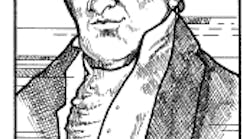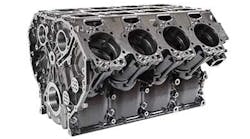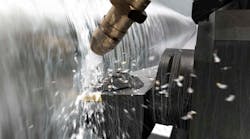1998 inductees honored for inventive genius, business acumen, distribution innovation, and design originality.
ELI WHITNEY (1765-1825)
Eli Whitney holds a preeminent position in the annals of metalworking. Although often incorrectly credited with the development of interchangeable machined parts for muskets, Whitney secured his reputation as an inventive genius with the development of his cotton gin, patented in 1794. This was a machine that would revolutionize cotton production and bring prosperity to the South.
The irony of this development was that, instead of making Whitney wealthy, it was his financial downfall. He frittered away his income on legal expenses fighting numerous manufacturers that had pirated his invention to meet the burgeoning demand.
This disappointing situation caused the resourceful Whitney to return North to New Haven to manufacture muskets for the government. Eli Whitney died in 1825, and the successful Whitney Arms Co. went on to impact and further the development of arms and the machines that made them.
It should be no surprise that the manufacturing creativity of Eli Whitney is recognized and honored by his election to the National Machine Tool Hall of Fame. Equally deserving are three other machine tool pioneers inducted in 1998: Lucian Sharpe whose astute business sense brought Brown & Sharpe to prominence, Henry Prentiss who shaped machine tool distribution in the U.S., and James N. Heald whose grinders revolutionized auto and aircraft engine cylinder production.
The Hall of Fame is located in the American Precision Museum, which occupies the landmark Robbins & Lawrence Armory building in Windsor, Vt. The Museum established the Machine Tool Hall of Fame in 1962. Inductees are honored for their contributions to machine tool development through original invention, marked innovation, or through the management of a group involved in development. Candidates must be deceased or totally removed from the industry for a minimum of three years to be eligible.
Since its inception, the Hall of Fame committee has been chaired by Anderson Ashburn, editor emeritus of AMERICAN MACHINIST. Operation of the Hall of Fame is supported by AMT The Association For Manufacturing Technology. Selection is made by electors representing different aspects of manufacturing technology. The Hall of Fame is displayed at the Museum and has traveled to each IMTS. A new traveling copy was displayed at IMTS '98 and is available for temporary display elsewhere.
Here are the citations for the four newest members along with a brief description of those previously elected.
A poor boy, Whitney made nails as a child and saved the money to pay his way to Yale College (now Yale University). In 1792 he visited the plantation, near Savannah, Ga., of Catharine Greene, widow of Revolutionary War general Nathanael Greene. While assisting the manager of a plantation, he learned of the problem with cotton as a crop because its short staples could not be separated from the seeds. Until now, this work had been done by hand. Whitney designed and built a model for a machine that would separate the seeds from the fiber — the first cotton gin. As a result of the gin, cotton could be cleaned so efficiently that it became the most important crop in the South and the basis for the region's profitable agricultural economy.
A disastrous factory fire prevented Whitney and his partner — plantation manager Phineas Miller — from producing enough gins to meet the demand. This, coupled with a high royalty set by Whitney and Miller, led manufacturers throughout the South to copy his invention. Although the gin was patented in 1794, a decision protecting the patent issued to Whitney and Miller was not rendered until 1807. In 1812, Congress denied Whitney's petition for renewal of the patent. Thus, Whitney profited very little from his invention.
Famous but still poor, he got backing for an arms works and in 1798 obtained a government contract for 12,000 muskets on the promise to make them with improved machinery in two years. It took him eight years and, contrary to myth, the guns did not have interchangeable parts. Small groups were filed to be inter-changeable, then marked and hardened, but he was successful enough to obtain a second contract for 15,000 muskets, followed by other contracts.
Whitney may have introduced special machines and division of labor, building on the type of factory system established earlier in the textile industry, but he did not achieve true part interchangeability.
Whitney has captured the popular imagination more than any person in the history of metalworking and even when the legends that have grown up around him are stripped away, he remains a major figure.
LUCIAN SHARPE (1830-1899)
Born in Providence, R.I., Sharpe signed on to a 5-year apprenticeship in 1848 under Joseph R. Brown to learn to be a watchmaker. His father paid a fee of $50 a year plus $2.50 a week for board. Sharpe made his own set of watchmaker's tools and built his watchmaker's lathe. In addition to mechanical skills, he soon demonstrated administrative ability. He wrote business letters for Brown, some in French. When his apprenticeship was completed, he was made a partner in J.R. Brown & Sharpe.
Disturbed by the confusion of gages to measure the thickness of wire and sheetmetal, he led the development of what became the standard American wire gage. He developed the Brown & Sharpe apprentice program that became the model for such programs. Woodbury has written, ". . .it was Brown who was the mechanical genius and Sharpe who was the outstanding businessman, but one who thoroughly understood, appreciated, and encouraged the work Brown was doing."
HENRY PRENTISS (1848-1943)
Prentiss started work in the treasurer's office of a cotton mill in Massachusetts, then went to Cincinnati as treasurer of the White Water Valley Railroad. In 1875, he moved to New York and began to manufacture taps, dies, and small tools and opened a store at 14 Dey Street to sell machine tools. In time, a group of machine tool companies formed known as the "Big Six" — Cincinnati Bickford, Cincinnati Grinders, Cincinnati Milling, Cincinnati Planer, Gould & Eberhardt, and Lodge and Shipley. Prentiss represented them all, plus Blanchard, Giddings & Lewis, and others, in a territory that included the entire country. In 1893, he gave the region beyond Pittsburgh to his Western representative, thus creating Marshall & Huschart, whose territory later divided again to create Motch & Merryweather. Prentiss continued to operate in the East until 1942, when the war brought an influx of orders that put a severe strain on his energy (he was 95) and the capital of his firm. Although, on March 1, 1942, Prentiss' firm shut down, he had shaped the method of machine tool distribution in the United States.
JAMES N. HEALD (1864-1931)
After graduating from Worcester Polytechnic, Heald became a partner with his father in the blacksmith shop, foundry, and machine shop his family had operated in Heald Village near Barre, Mass., for 60 years. In 1903, he obtained financing to buy the firm from his father and moved it to Worcester. He had already developed a lathe attachment for both internal and external grinding and a successful drill point grinder. In 1905, Heald introduced a rotary grinder for the sides of piston rings. This brought him in contact with the problems encountered with cylinders for auto engines. Boring, reaming, and lapping were the usual methods. Grinding was ruled out because of the difficulty of rotating an engine block around the cylinder centerline. The thin walls would spring away from the boring tool causing an uneven surface. In 1905, Heald devised a grinding machine with a planetary action that was so well designed that today's machines differ little. It quickly became the standard production method for both auto and aircraft engines. Later he added automatic size control, developed hydraulic table feed, and centerless internal grinders.
Whitney, Sharpe, Prentiss, and Heald join these others:
John H. Hall (1781-1841)
In 1811, while supervising the production of a rifle of his design at Harper's Ferry Armory, Hall devised and built sturdy milling machines with guides and stops such that truly interchangeable parts were produced. He devised gaging systems to maintain accuracy ensuring part interchangeability.
Frank Lyman Cone (1863-1936)
Cone designed a four-spindle automatic that broke with all previous designs. He put all the cams at the top on one long shaft. This made it possible to build large multiple-spindle machines that had the operating positions at a convenient working height.
Richard E. LeBlond (1900-1995)
He led the R.K. LeBlond Machine Tool Co. from 1940 to 1965, producing lathes for large caliber guns and automated lathes after WWII. The company developed the first continuous-path numerically controlled lathe in 1960.
John Herkenhoff (1905-1996)
John Herkenhoff became general manager of Minster Machine in 1935 and president in 1939. Under his management, researchers at Minster obtained 61 patents, including a series of improvements in air friction clutches that culminated in 1947 with one that doubled the speed possible with mechanical clutches.
William Sellers (1824-1905)
Sellers obtained more than 90 machine-tool patents. His machines were heavier than others. He abandoned the beads and embellishments then common and started the practice of painting all machine tools gray. Sellers was responsible for the emphasis on American machinery at the 1876 Centennial.
Francis A. Pratt (1827-1902)
This leading developer and producer of milling machines is credited with the design of the Lincoln mill. His partnership with Amos Whitney produced 7,000 Lincoln mills as well as lathes, drilling machines, shapers, and a variety of special machines.
E. W. Bliss (1836-1903)
Bliss built and managed a farranging press manufacturing business. After working for a printing press producer, and a failed start in New Haven, Bliss established a press builder in Brooklyn that covered 85 blocks and employed 13,000 people at the time of his death.
Ambrose Swasey (1846-1937)
Swasey invented several lathe and gearcutting machines and was cofounder with Worcester Warner of the firm that bore their names. Swasey developed the machines and did the engineering for the astronomical telescopes for which the firm also became famous.
William Lodge (1848-1917)
He is remembered for his leader-ship as an exporter and industry organizer. At Lodge & Davis in Cincinnati, exports exceeded capacity, so Lodge helped start other firms to supply them. About half the firms in Cincinnati in 1900 were strongly influenced by Lodge.
Abraham B. Landis (1851-1923)
His machine designs, especially in grinders, aided in the mass production that enabled the fledgling U.S. auto industry to grow. While an apprentice building farm machinery, he developed the Landis universal grinder.
Charles H. Norton (1851-1942)
Unable to sell his idea of a heavy plain grinder with wide wheels and high horsepower to eliminate the final lathe cut, Norton left Brown & Sharpe. At Norton Grinding Co. he developed machines that took plunge cuts and ground to size on a production basis.
James Hartness (1861-1934)
In 1891, he patented the Hartness flat-turret lathe, which replaced the barrel arrangement and became the mainstay at Jones & Lamson for a third of a century. He encouraged re-search of Fellows and Bryant, and backed them in starting their own companies.
William Davenport (1861-1937)
While at Brown & Sharpe, Davenport designed its automatic screw machine, then started his own firm and developed special machines for clock manufacture. In 1910, Davenport introduced his first unique five-spindle Davenport automatic screw machine.
Richard K. LeBlond (1864-1953)
LeBlond had a small firm producing printing supplies when Lodge recruited him to produce lathes for Lodge & Davis. The next year he produced a lathe of his own design. LeBlond developed a gear-driven headstock in 1903, crankshaft lathes, and many other special types.
Ralph Kraut (1908-1985)
Under Kraut, who was made president after WWII, Giddings & Lewis produced the first NC skin mill, and developed its own controls. Kraut greatly broadened the firm's operations, acquiring Cincinnati Bickford, Kaukauna Machine, Kelly Reamer, Prescott, Gisholt, and Gilman in the U.S. and Fraser in Scotland.
Simeon North (1765-1852)
North is credited with the invention of the milling machine, the first entirely new type of machine tool invented in America, and the machine that made inter-changeable parts practical by replacing filing. His 1813 contract for pistols was the first to specify interchangeable parts.
David Wilkinson (1771-1852)
His 1794 screw-cutting lathe employed a slide rest, later patented, that led the way for other influential designs, possibly including that of English lathe pioneer Henry Maudsley. His 1806 version permitted a simple filing method to correct for irregularities in the ways.
Joseph R. Brown (1810-1876)
Inventor of the universal grinding machine, he developed an automatic linear dividing machine, improved Howe's turret screw machine, and developed a milling cutter for gear teeth that sharpened by cutting away the face of each cutter tooth.
Frederick W. Howe (1822-1891)
Howe was an inventor and developer of several important milling and turning machines at Robbins & Lawrence, at a firearms firm in New Jersey, the Simeon North firm, and finally the Providence Tool Co., where he interested Joseph Brown in machine tools.
Edwin R. Fellows (1865-1945)
While he was working for Hartness, the Fellows gear shaper was developed, a classic and original design. Key to the process was the use of a complete gear as a cutter. He also designed the machine to produce the cutters that foreshadowed production gear grinding machines.
Winthrop Ingersoll (1865-1928)
Making cutters for slab milling, he found the machines too weak for his cutters and built a heavy milling machine. He developed the adjustable-rail milling machine and concentrated on building special machines, starting with a cylinder block machine for the Model T.
James Gleason (1868-1964)
He contributed to the technology of transmitting power around corners with a series of inventions and 36 patents, some of which include a generating action machine, the first spiral-bevel generator to use a circular face milling cutter, and the Formate generator.
Theodore Trecker (1868-1955)
In 1898, he and E. J. Kearney left Kempsmith, a pioneer milling machine producer, to start Kearney & Trecker, concentrating on milling machines. Trecker introduced a geared feed box and later a geared spindle drive, flood lubrication, and rapid traverse.
George O. Gridley (1869-1956)
At the Windsor Machine Co., he developed an automatic turret lathe, followed in 1907 with a four-spindle automatic screw machine. After selling the company to National Acme, he started New Britain Machine to produce a new design. He held more than 60 patents on his machine designs.
Edward P. Bullard, Jr (1872-1953)
Bullard developed a machine that combined the advantages of the vertical lathe and the turret lathe, producing the vertical turret lathe. Later he led development of the vertical spindle "Mult-Au-Matic" that became a major machine tool in the auto industry.
William L. Bryant (1875-1931)
While working on turret lathe designs, he became interested in grinding and developed a grinder that chucked the work and had three heads for internal, external, and face grinding. Bryant applied for his first patent in 1902 and started his own firm in 1909.
Charles B. DeVlieg (1892-1973)
He developed a bed-type mill and a horizontal boring machine with precision approaching the jig borer, which he called the Jigmil. It was the accurate repeatability of this machine that convinced the Air Force that Parson's NC concept was practical.
Edward J. Kingsbury (1893-1973)
Working in his father's toy company, Kingsbury developed the friction drive drilling machine to drill through hard spots in cast iron wheels for toy automobiles. Later he placed the drilling units around a rotary table for high production, to produce a rotary transfer machine.
Frederick V. Geier (1894-1981)
Geier led modern science into machine design and shaped the character of the company that became Cincinnati Machine A Unova Co. He established a basic research department that conducted studies on chip formation and the mechanism of cutting.
Richard F. Moore (1896-1987)
Moore developed a jig borer using a hardened leadscrew instead of end measures, gaining worldwide recognition. The jig grinder, a universal measuring machine, and other instruments are credited with giving metalworking plants an additional decimal point of accuracy.
Rudolph Bannow (1897-1962)
Bridgeport Machines was producing a high-speed milling attachment, from which Bannow developed a turret milling machine introduced in 1938. More than a quarter million of the machines became the basis of the "tool and die" business of thousands of small jobshops.
Francis J. Trecker (1909-1987)
In 1950, Trecker began producing NC profilers and skin mills and in 1953 began a joint project with Hughes Tool to produce an NC transfer machine. He brought Wallace Brainard from Hughes to develop a single machine that combined the features of the Hughes line, producing the machining center.
John T. Parsons (1913- )
Parsons developed a method for producing contoured templates to check helicopter blades and later convinced the Air Force that the method could be developed into a three dimensional numerically controlled machine tool.
Ralph E. Cross (1910- )
From the gear-tooth rounding machine developed by his father, Cross led the company into transfer machines, developing preset tools, tool control systems, sectionalized transfer lines, ballscrew feed units, and computerized machine tool systems.










